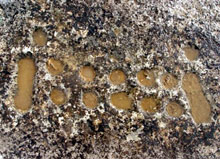The article “Discovery of 3000-Years old Board-Games and a Compass-Rose in Persian Gulf’s Kharg Island” was posted in the CAIS (Circle of Ancient Iranian Studies) venue hosted by Shapour Suren-Pahlav. The article has been slightly edited from its original version posted by CAIS on April 18, 2008.
=====================================================================================
An ancient four-pointed compass-rose showing directions of ‘four cardinal points’ and a number of board-games carved on rocks discovered in the Iranian island of Kharg in the Persian Gulf, reported Persian service of CHN on Saturday. The discovery was made by Shahram Eslami, a local and a member of Kharg’s Friends of Cultural Heritage. The relics were studied and their ancient origins identified by Reza Moradi Ghiasabadi, who made the following observations:
“The engravings are between 2000 and 3000 years old. The first discovered carving is located beside an ancient road which is a four-pointed compass-rose showing directions of four cardinal points within a square-shape with rounded angles setting, 50x50cm in diameters. Some sections of the compass-rose have been damaged, apparently as the result of a cracks in the rock… the compass-rose’s lines have been placed in a position to determine the cardinal points, which have only two degrees of error based on the Global Positioning System (GPS)… This is a unique discovery and a great deal of efforts and resources should be made available to safeguard the relic. Also we must not remove it from its original place…”
The remaining carvings which are board-games were discovered in the northwest of the island. The board-games are in a mixture of circular and oblong shape settings, in various diameters, some 4cm and some in 10cm in circumference (see the picture). All these carvings engraved over the rocky-ground’s flat surfaces. These are located on the hinterland at the top of the cliff overlooking the waters of the Persian Gulf.
These game-boards have been carved on the rocks in various settings, which Ghiasabadi have managed to identify seven of them. Some of them could be a proto-type for backgammon.

Remains of the 3000-year old relics discovered in Kharq Island (Source: CAIS & Cultural Heritage Agency of Iran).
The Persian Gulf’s Iranian island of Kharg is situated at about 30 km northwest of Bandar-e Rig and 52 km northwest of Bushehr. It is the larger and more southerly of two islands (the other being Khargu). Kharg (also Khark) is about 8 km long and, at its widest point, 4 km across. The interior is hilly, terminating in cliffs at the northern and southern ends of the island.
Archaeologists have always believed the oldest settlement on the island dates back to Parthian dynastic era (248 BCE-224 CE), but as the result of a discovery in November 2007 history of the island was re-written, as the archaeologists have discovered an inscription (… for more see here …) executed in Old-Persian cuneiform, dated to the Achaemenid dynasty (550-330 BCE). Since its discovery, the rock-inscription has been left unprotected in its original place at the mercy of looters, vandals, and harsh weather.



